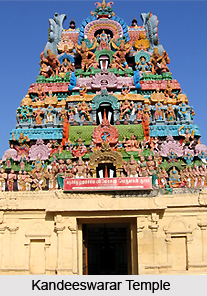 Kandeeswarar Temple is also referred to as Brahma Sira Kandeeswarar Temple and is located in Thirukkandiyur close to the region of Thiruvaiyaru in the southern Indian state of Tamil Nadu, categorized as a `Paadal Petra Sthalam`. Lord Shiva is the presiding deity of this Hindu temple which finds mention in the hymns of the saint Tirugnana Sambandar. Situated on the Kumbakonam-Thiruvaiyaru - Tanjore Road, at a distance of nearly 21 kms away from Kumbakonam and 2 kms away from Thiruvaiyaru, the temple is amongst the seven different holy shrines linked to `Saptamartrikas` or the seven female holy deities of the Shiva temple.
Kandeeswarar Temple is also referred to as Brahma Sira Kandeeswarar Temple and is located in Thirukkandiyur close to the region of Thiruvaiyaru in the southern Indian state of Tamil Nadu, categorized as a `Paadal Petra Sthalam`. Lord Shiva is the presiding deity of this Hindu temple which finds mention in the hymns of the saint Tirugnana Sambandar. Situated on the Kumbakonam-Thiruvaiyaru - Tanjore Road, at a distance of nearly 21 kms away from Kumbakonam and 2 kms away from Thiruvaiyaru, the temple is amongst the seven different holy shrines linked to `Saptamartrikas` or the seven female holy deities of the Shiva temple.
Legend of Kandeeswarar Temple
According to a Hindu legend, once Parvati, Lord Shiva`s consort had performed `patha pooja` or ablution of the feet to Lord Brahma instead of Lord Shiva out of confusion as both the Hindu Gods possessed five heads each. This infuriated Lord Shiva who chopped off one of the heads of Lord Brahma but was instantly cursed by the latter which made His severed head adhere to His hand. Shiva then prayed to Lord Vishnu to purify His son, at Thirukarambanur as `Bhikshadana`, which relieved a part of his sin. After worshipping Vishnu at Thirukandiyur and taking a sacred dip in Kamala Pushkarani temple tank, His sins were completely relieved. The temple is termed as Hara Saabha Vimochana Temple as the sin or `saabha` of Lord Shiva or `Hara` was cleansed (`vimochana`). Thereafter, the temple tank was recognized as the `Kapala Theertham` (kapala meaning skull) and the temple of Hara Sabha Vimochana Temple was constructed by Lord Shiva. He is also said to have erected a temple dedicated to Himself close to it.
Another legendary tale states that Goddess Lakshmi has requested Lord Shiva to cut off one of the heads of Lord Brahma since She feared her husband Lord Vishnu would shower all His love towards Lord Brahma. As per yet another legend, Lord Vishnu was worshipped by the moon or `Chandra`, King Mahabali and Bhrigu Rishi, who purified all their sins. Once the sage Bhrigu made attempts to examine the superiority of Lord Shiva, Lord Brahma and Lord Vishnu and kicked Vishnu in the chest out of anger. Immediately his sins were cleansed. Chandra had seduced the wife of Lord Vishnu and His sins were slightly relieved by His prayers in Hara Saabha Vimochana Perumal.
Religious Significance of Kandeeswarar Temple
Kandeeswarar Temple is the fifth temple of the seven `saptasthanas` of Aiyarappar Temple which is based at Thiruvaiyaru and is particularly noted for its beautiful Chola sculptures. The temple has been greatly revered by the hymns of the Tamil saints Campantar and Appar who lived in the 7th century. Every year in the month of April, the Sapta Sthanam festival is organised and is attended by innumerable pilgrims who can notice the parade of the seven glass palanquins. These palanquins possess the deities of the seven temples comprising Kandeeswarar Temple, Aiyarappar Temple, Apathsahayar Temple, Vedapurishwarar Temple, Neyyadiappar Temple, Odhanavaneshwarar Temple and Puvananathar Temple. A flower festival or `Poochorithal` is arranged wherein flowers are offered to the deities by the dolls.





















